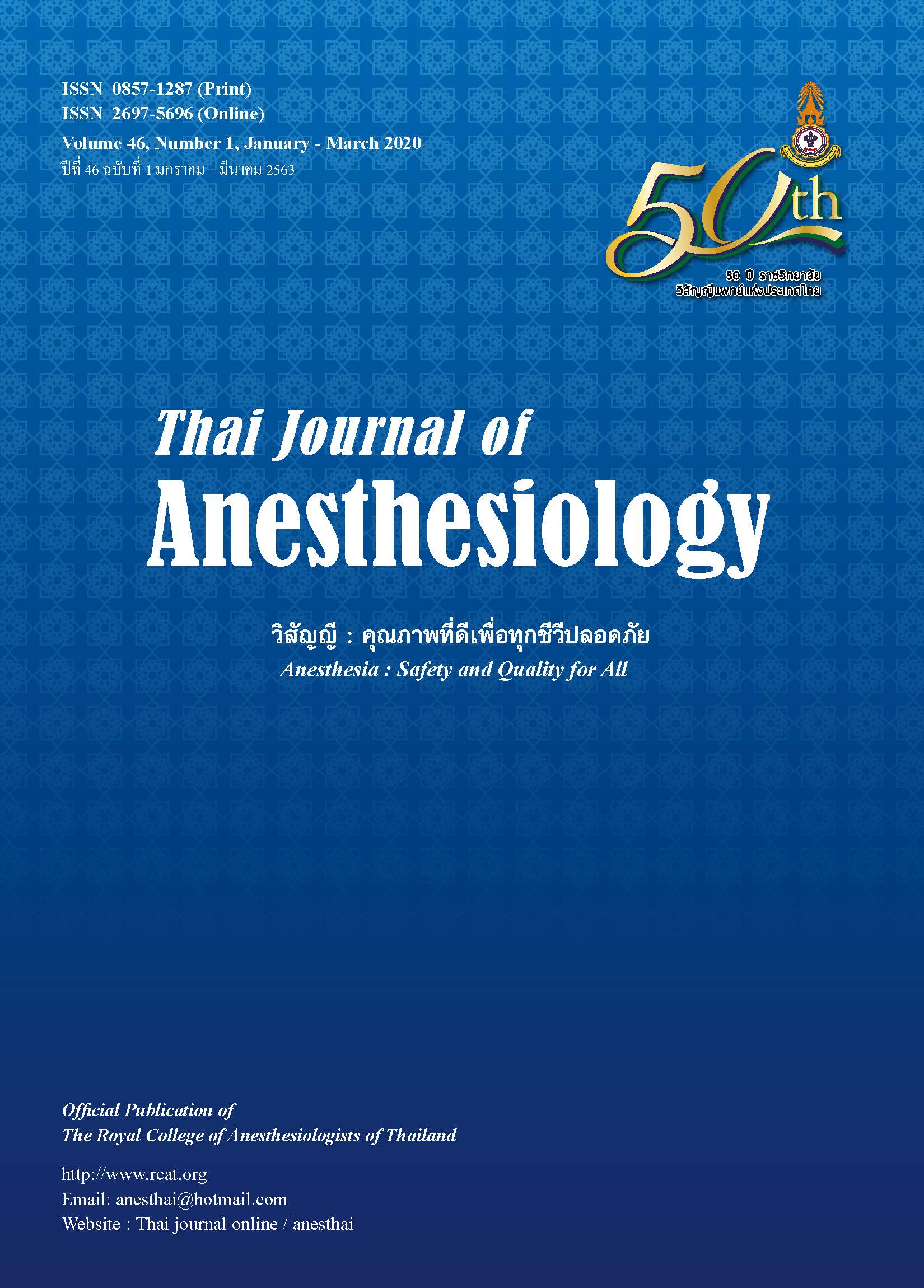ยา Levobupivacaine ความเข้มข้นต่ำสำหรับการใส่สายระงับความรู้สึก ที่เส้นประสาท Femoral ในผู้ป่วยผ่าตัดเปลี่ยนข้อเข่าร่วมกับมอร์ฟีน 0.1 มิลลิกรัม ทางไขสันหลัง
Main Article Content
บทคัดย่อ
หลักการ: ความปวดหลังผ่าตัดเปลี่ยนข้อเข่าเป็นความปวด
ระดับปานกลางถึงรุนแรง การระงับปวดที่ดีทำให้ผู้ป่วย ฟื้นตัว
ได้เร็ว การศึกษานี้ต้องการเปรียบเทียบผลของ levobupivacaine
ความเข้มข้น 0.04% ร่วมกับมอร์ฟีนเข้าทางไขสันหลังปริมาณ
0.1 มิลลิกรัม เทียบกับความเข้มข้น 0.1%ในการระงับปวด
ผ่าตัดเปลี่ยนข้อเข่า
วิธีการศึกษา: เป็นงานวิจัยเชิงทดลองแบบปกปิดสองทางใน
ผู้ป่วยที่มารับการผ่าตัดเปลี่ยนข้อเข่า ผู้ป่วยกลุ่ม LBM ได้รับ
levobupivacaine 0.04% ร่วมกับมอร์ฟีน 0.1 มิลลิกรัมทาง
ไขสันหลัง ส่วนกลุ่ม BM ได้รับ levobupivacaine 0.1% หยด
ต่อเนื่องทาง femoral block เป็นเวลา 48 ชั่วโมงหลังการ
ผ่าตัด ประเมินความปวดหลังผ่าตัดที่เวลา 6, 12, 24, 48
ชั่วโมง ปริมาณมอร์ฟีนที่ใช้จากเครื่องให้ยาแก้ปวดด้วยตนเอง
(PCA) และผลข้างเคียง เช่น คลื่นไส้อาเจียน คัน กล้ามเนื้อ
ขาอ่อนแรง
ผลการศึกษา: ผู้ป่วยทั้งหมด 46 ราย กลุ่ม LBM มีคะแนน
ความปวดที่ 6 ชั่วโมงหลังผ่าตัดทั้งขณะพักและขณะ
เคลื่อนไหว น้อยกว่ากลุ่ม BM อย่างมีนัยสำคัญทางสถิติ
(3.88 vs 1.61, p=0.005) และ (5.88 vs 3.39, p=0.02)
ตามลำดับ ส่วนที่ 12 ชั่วโมง กลุ่ม LBM มีคะแนนความปวด
ขณะเคลื่อนไหวต่ำกว่ากลุ่ม BM อย่างมีนัยสำคัญทางสถิติ
(5.33 vs 4.42, p=0.034) ที่ 24 ชั่วโมงกลุ่ม LBM มีกล้ามเนื้อ
ขาอ่อนแรงน้อยกว่ากลุ่ม LB (Bromage score I, 29.4% vs
69.4%, p=0.028) ไม่พบความแตกต่างของปริมาณการใช้
มอร์ฟีน คลื่นไส้อาเจียน คัน ระหว่างผู้ป่วยสองกลุ่ม
สรุป: การให้ levobupivacaine 0.04% ระงับกระแสประสาท
ของเส้นประสาท femoral อย่างต่อเนื่องร่วมกับมอร์ฟีน 0.1
มิลลิกรัมทางไขสันหลัง สามารถระงับปวดหลังผ่าตัดเปลี่ยน
ข้อเข่าได้อย่างมีประสิทธิภาพ
Article Details
เอกสารอ้างอิง
morphine for postoperative analgesia: a randomized,
controlled, dose-ranging study after hip and knee
arthroplasty. Anesth Analg 2003;97:1452-7.
2. Millar WJ: Hip and knee replacement. Health Rep 2002;14:
37-50.
3. Allen RS, Thorn BE, Fisher SE, et al. Prescription and dosage
of analgesic medication in relation to resident behaviors in
the nursing home. J Am Geriatr Soc 2003;51:534-8.
4. Arpino L, Iavarone A, Parlato C, Moraci A. Prognostic role of
depression after lumbar disc surgery. Neurol Sci 2004;25:
145-7.
5. Lang SA: Postoperative analgesia following total knee
arthroplasty: A study comparing spinal anesthesia and
combined sciatic femoral 3-in-1 block. (Letter) Reg Anesth
Pain Med 1999;24:97.
6. Choi P, Bhandhari M, Scott K, Douketis JD: Epidural
analgesia for pain relief following hip or knee replacement.
Cochrane Database of Systemic Reviews 2003;3:CD003071.
7. Bailey PL, Rhondeau S, Schafer PG, et al. Dose response
pharmacology of intrathecal morphine in human volunteers.
Anesthesiology 1993;79:49-59.
8. Cousins MJ, Mather LE. Intrathecal and epidural
administration of opioids. Anesthesiology 1984;61:276-310.
9. Gehling M, Tryba M. Risk and side effects of intrathecal
morphine combined with spinal anaesthesia: a metaanalgesia.
Anaesthesia 2009:64:643-651.
10. Buvanendran A, Tuman KJ, McCoy DD, Matusic B, Chelly
JE: Anesthetic techniques for minimally invasive total knee
arthroplasty. J Knee Surg 2006;19:133-6.
11. Bauer M, Wang L, Onibonoje OK, et al. Continuous femoral
nerve blocks: decreasing local anesthetic concentration to
minimize Quadriceps Femoris weakness. Anesthesiology
2012;116:665-72.
12. Pelt CE, Anderson AW, Anderson MB, Van Dine C, Peters
CL. Postoperative falls after total knee arthroplasty in patients
with a femoral nerve catheter: Can we reduce the incidence?
J Arthroplasty 2014;14:18-7.
13. Widmer B, Lustig S, Scholes CJ, Molloy A, Leo SP, Coolican
MR, Parker DA. Incidence and severity of complications due
to femoral nerve blocks performed for knee surgery. Knee
2013;20:181-5.
14. Capdevila X, Barthelet Y, Biboulet P, Ryckwaert Y,
Rubenovitch J, d’Athis F. Effects of perioperative analgesic
technique on the surgical outcome and duration of
rehabilitation after major knee surgery. Anesthesiology 1999;
91:8-15.
15. Richman JM, Liu SS, Courpas G, et al. Does continuous
peripheral nerve block provide superior pain control to
opioids? A meta-analysis. Anesth Analg 2006;102:248-57.
16. Wasserstein D, Farlinger C, Brull R, Mahomed N, Gandhi R.
Advanced age, obesity and continuous femoral nerve
blockade are independent risk factors for inpatient falls after
primary total knee arthroplasty. J Arthroplasty 2013;28:1121-4.
17. Gerbershagen HJ. Pain intensity on the first day after surgery.
Anesthesiology 2013;118:934-44.
18. Rathmell JP, Pino CA, Taylor R, Patrin T, Viani BA. Intrathecal
morphine for postoperative analgesia: a randomized
controlled, dose-randing study after hip and knee
arthroplasty. Anesth Analg 2003;97:1452-7.
19. Ackerman DB, Trousdale RT, Bieber P, Henely J, Pagnano
MW, Berry DJ. Postoperative patient falls on an orthopedic
inpatient unit. J Arthroplasty 2010;25:10-14.


